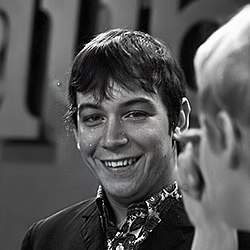Calling All Earthlings 2018

In 1950s California, George Van Tassel, a confidant of Howard Hughes, claims to channel alien guidance and draws upon Nikola Tesla's inventions to build the Integratron, a mysterious dome-shaped structure. As followers gather in the desert, the FBI investigates, suspecting potential unrest. The story explores the intrigue surrounding the Integratron's construction and purpose, ultimately questioning the fate of humanity and revealing unexpected secrets.
Does Calling All Earthlings have end credit scenes?
No!
Calling All Earthlings does not have end credit scenes. You can leave when the credits roll.
Meet the Full Cast and Actors of Calling All Earthlings
Explore the complete cast of Calling All Earthlings, including both lead and supporting actors. Learn who plays each character, discover their past roles and achievements, and find out what makes this ensemble cast stand out in the world of film and television.
External Links and Streaming Options
Discover where to watch Calling All Earthlings online, including streaming platforms, rental options, and official sources. Compare reviews, ratings, and in-depth movie information across sites like IMDb, TMDb, Rotten Tomatoes or Metacritic.
Ratings and Reviews for Calling All Earthlings
See how Calling All Earthlings is rated across major platforms like IMDb, Metacritic, and TMDb. Compare audience scores and critic reviews to understand where Calling All Earthlings stands among top-rated movies in its genre.

The Movie Echo Score
Calling All Earthlings balances an intriguing array of historical and mystical elements with structural unevenness. Reviews highlight its original blend of cult history and science-fiction motifs alongside a disparate, clip-driven format that sometimes undermines narrative focus. While its vivid visuals and thematic depth offer engaging moments, inconsistent character portrayal and episodic pacing lessen overall cohesion. The net effect is a moderately compelling documentary that captivates through concept more than execution, delivering an uneven yet still worthwhile viewing.
The Movie Echo Score Breakdown for Calling All Earthlings

Art & Craft
In terms of art and craft, Calling All Earthlings demonstrates visual flair through its carefully composed photography. Critics note moments of beautifully framed desert imagery and inventive use of camera angles that enhance thematic resonance. However, occasional overuse of lens effects and unconventional shot compositions can feel distracting rather than purposeful. These elements combine to deliver a largely engaging aesthetic that occasionally undermines clarity.

Character & Emotion
When it comes to character and emotion, the film’s portrayal of its subjects oscillates between engaging warmth and superficial depiction. Its neutral stance allows for spontaneous humor among followers, yet attention to individual depth remains limited. Critics point to underdeveloped profiles that leave central figures feeling enigmatic rather than fully formed. Overall, the emotional connection is uneven, yielding moments of genuine curiosity amid persistent detachment.

Story & Flow
In terms of story and flow, Calling All Earthlings offers an original blend of post-war history, cult narratives, and speculative elements that some find deeply engaging. The film’s episodic collage structure and intermittent pacing introduce a sense of discovery, although they also contribute to a scattered progression and occasional confusion. Ultimately, the documentary’s inventive concept delivers sufficient intrigue despite its structural inconsistencies.

Sensory Experience
Regarding sensory experience, the documentary presents a compelling audiovisual landscape through its use of synthesizer-infused score and varied visual textures. Moments of atmospheric sound design enhance the sense of mystique surrounding the setting, complemented by striking color and composition. However, reviewers note that occasional overapplication of foggy filters and atypical angles can distract from content, resulting in a sensory palette that is intriguing but uneven.

Rewatch Factor
The rewatch factor is modest, as the film’s strength lies primarily in its novel themes rather than layered narrative complexity. While the intriguing mix of historical anecdotes and mystical speculation invites further exploration, uneven pacing and sparse character focus limit the appeal of subsequent viewings. Consequently, repeat watches may yield incremental insights, but the documentary’s structural disjointedness may deter some audiences from revisiting.

55
Metascore
tbd
User Score


63%
TOMATOMETER

100%
User Score

6.8 /10
IMDb Rating

61
%
User Score
Take the Ultimate Calling All Earthlings Movie Quiz
Challenge your knowledge of Calling All Earthlings with this fun and interactive movie quiz. Test yourself on key plot points, iconic characters, hidden details, and memorable moments to see how well you really know the film.
Exploring Calling All Earthlings: Test your knowledge about the intriguing film 'Calling All Earthlings' and its fascinating exploration of George Van Tassel's life and the Integratron.
In which year did George Van Tassel abandon his job to move to the Mojave Desert?
1945
1946
1947
1948
Show hint
Full Plot Summary and Ending Explained for Calling All Earthlings
Read the complete plot summary of Calling All Earthlings, including all major events, twists, and the full ending explained in detail. Explore key characters, themes, hidden meanings, and everything you need to understand the story from beginning to end.
In 1947, George Van Tassel, a former employee and confidant of Howard Hughes, makes the bold decision to leave behind his mundane life in Los Angeles filled with postwar anxiety. He relocates with his family to the serene Mojave Desert, where they make their home beneath a massive boulder. As he abandons the chaos of the city, he finds solace in the magnificent tranquility that Joshua Tree offers.
The turning point comes during the full moon in August 1953, when he encounters extraterrestrial beings who share with him the blueprint for a revolutionary rejuvenation device he dubs “The Integratron.” This moment convinces Van Tassel that he has been chosen by these extraterrestrial visitors, led by Solganda, whose voice intriguingly resembles that of Ronald Coleman. Inspired, he embarks on an ambitious project to create a monumental dome capable of opening portals through time and space, merging the received wisdom with the groundbreaking work of Nikolai Tesla and other visionary scientists.
Long before contemporary shows like The X-Files and Stranger Things captured imaginations with themes of otherworldly contact, the harsh realities of nuclear threats and social conformity compelled artists, innovators, and adventurers in the postwar era to flock to the desert. They sought new lifestyles and futures while residing in the jack-rabbit shacks, plots of land allocated by the government through the Small Tract Act of 1938.
As a self-taught inventor and skilled pilot, Van Tassel quickly rises to prominence, becoming one of the pioneering figures of alien contact culture. His endeavors combine science with spirituality, forging a vision of a new utopia through the creation of the Integratron, which aims to resolve the issues of aging and harness unlimited energy for the world.
During the 1950s, Van Tassel sets in motion the Interplanetary Spacecraft Conventions to promote the dome and advance his anti-nuclear sentiments. Many affluent individuals from Los Angeles, eager for rejuvenation, support his project, including his old boss, Howard Hughes, who shares Van Tassel’s concerns about contamination. Together, they contribute significantly to the development of the dome.
With the help of his neighbors, including an early follower of Yogananda, Van Tassel actualizes his dream, working tirelessly to complete the dome and prepare for its activation. His crusade attracts a diverse group of people to the area, igniting a peace-loving, alien-inspired movement. This convergence brings together an eclectic mix of alternative scientists, FBI agents, and eccentric individuals, all compelled by the burgeoning American Dream as they seek to either support or obstruct this emerging reality.
However, challenges arise as the Integratron’s location poses a dilemma; it sits adjacent to one of the largest military installations worldwide, the Marine Corps Air Ground Combat Center, in Twentynine Palms. Balancing the scene is the enigmatic Giant Rock, a site with deep cultural significance to American Indians and a history of conflict.
The complexities of the Integratron’s design unfold as its purposes remain cryptic. Although some of its electromagnetic principles prove promising, they require precise adjustment; failure to calibrate could lead to catastrophic consequences as one participant warns: >“Southern California could be blown off the map.” As the project nears completion, unexpected twists threaten the culmination of Van Tassel’s vision.
Ultimately, the Integratron serves different purposes for various individuals: some see it as a means for global colonization, others perceive it as a chance for companionship and guidance, while for many, it becomes a vibrant hub for culture and art. Calling All Earthlings vividly shares these narratives through the voices of both current and past inhabitants of the Joshua Tree region, featuring notable personalities such as Eric Burdon, medicine woman Valerie Brightheart, historian Ernest Siva of the Morongo Indians, publisher Art Kunkin, and the contemporary custodians of the dome, the Karl sisters. Supplementing the story are insights from esteemed Californian historian Dr. Kevin Starr, skeptical astronomer Bob Berman, and futurist duo Drs. JJ and Desiree Hurtak.
Accompanied by a celestial score crafted by Elliott Sharp alongside the legendary Harmonia, and other creative collaborators like Clive Wright and Dave Catching’s Earthlings?, this documentary presents an enigmatic exploration of the boundary-defying culture inherent to Joshua Tree and its inhabitants, all the while patiently awaiting their spacecraft.
Uncover the Details: Timeline, Characters, Themes, and Beyond!

Coming soon on iOS and Android
The Plot Explained Mobile App
From blockbusters to hidden gems — dive into movie stories anytime, anywhere. Save your favorites, discover plots faster, and never miss a twist again.
Sign up to be the first to know when we launch. Your email stays private — always.
Watch Trailers, Clips & Behind-the-Scenes for Calling All Earthlings
Watch official trailers, exclusive clips, cast interviews, and behind-the-scenes footage from Calling All Earthlings. Dive deeper into the making of the film, its standout moments, and key production insights.
Calling All Earthlings Themes and Keywords
Discover the central themes, ideas, and keywords that define the movie’s story, tone, and message. Analyze the film’s deeper meanings, genre influences, and recurring concepts.

Unlock the World of Movies with Our Comprehensive Wiki
Dive into our Movie Wiki for in-depth film encyclopedia entries, including cast biographies, production trivia, plot synopses, behind-the-scenes facts, and thematic analyses. Whether you’re researching iconic directors, exploring genre histories, or discovering hidden easter eggs, our expertly curated movie database has everything you need to fuel your cinematic passion.

Similar Movies To Calling All Earthlings You Should Know About
Browse a curated list of movies similar in genre, tone, characters, or story structure. Discover new titles like the one you're watching, perfect for fans of related plots, vibes, or cinematic styles.
Quick Links: Summary, Cast, Ratings, More

What's After the Movie?
Not sure whether to stay after the credits? Find out!
Explore Our Movie Platform
New Movie Releases (2026)
Famous Movie Actors
Top Film Production Studios
Movie Plot Summaries & Endings
Major Movie Awards & Winners
Best Concert Films & Music Documentaries
Movie Collections and Curated Lists
© 2026 What's After the Movie. All rights reserved.
































